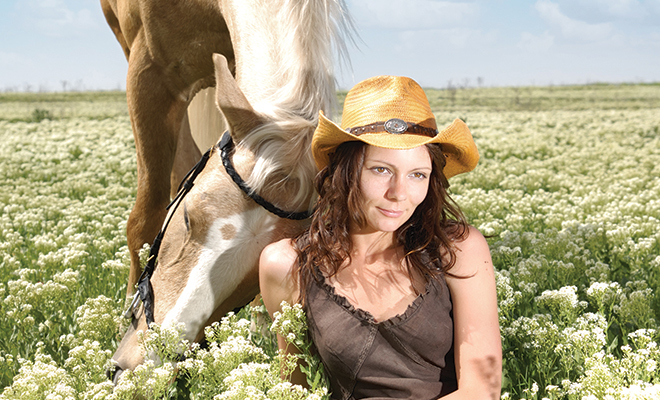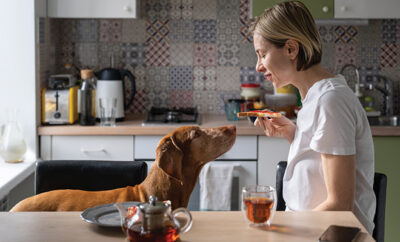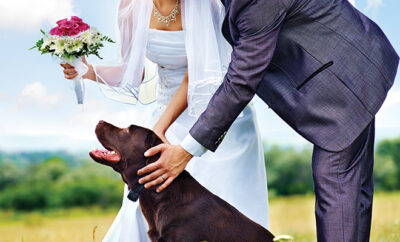
Equine Intelligence: Partnering Humans and Horses
The graceful ballet of horse and rider is a visual representation of the deep relationship that develops between two unique individuals over time. In truth, what an observer notices in this seamless unit barely scratches the surface of the depth of connection between humans and horses.
How is this bond developed between a human and horse? Donna West of Developing Partnerships in Calera, Alabama, says, “Leadership is the key to creating trust and a long-lasting bond with your horse. The handler’s assertiveness mimics the relationships among the alpha horse and other horses in the herd and reminds your horse that you’re the one in control, what I call a ‘kind alpha horse.’ It’s the equivalent of the relationship between parent and child; if you maintain that leadership, you’ll develop a life-long bond with the horse.”
Donna, who’s handled and trained horses most of her life, is a practitioner and trainer of “natural horsemanship,” a method described in Nicholas Evans’ The Horse Whisperer. “The theory is that you study and work with herd behavior and equine body language, using it to get the attention of the horse and the response that you want. Your goal is to counter the horse’s fight-or-flight instinct and to work with him to think rather than to react.”
The blend of human leadership and equine instincts is profoundly demonstrated in the field of equine-assisted therapy. Michelle Holling-Brooks, founder and director of Unbridled Change in Boone’s Mill, Virginia, has been in the field of equine-assisted activities and therapies for more than 15 years. She’s certified by the Professional Association of Therapeutic Horsemanship and the Equine Assisted Growth and Learning Association, leaders in using equine therapy to change the lives of persons struggling with obstacles in their lives. “As a life-long horse person, I know how powerful the bond between a human and a horse can be,” Michelle affirms. “The horse is not only a recreational or sport partner, but a participant in personal and emotional healing as well. For me personally, a horse literally gave me back the ability to walk.”
At 13, Michelle developed encephalitis and meningitis from a mosquito bite and spent three months in the hospital, two of those in a coma. “When I woke up I had no use of my legs, was deaf in both ears and so sensitive to light I was basically blind. I had no memory of my life prior to waking,” Michelle describes. Her parents took her to the barn in hopes of stimulating her to interact and remember. “I clearly remember being wheeled down the aisle; most of the horses put their heads out of their stalls. I remembered my horse, Schedule A, something I shouldn’t have. He reached his head over me and we sat that way for what seemed like forever. The one bond in the world I remembered was not a person, parent or sibling–it was a horse.”
From riding three or four times a week, Michelle’s brain began to heal damaged pathways and she learned to walk again. “But more than giving me back my legs, horses gave me a safe place to rediscover who I was, to gain confidence without fear of judgment, which I got from the human world. I found I had a special connection to work with horses. As a trainer, I had the reputation for being able to reach horses that have been hurt deeply.”
It was a natural progression for Michelle to partner people with horses to help create the opportunity for healing. “The horse wants to follow our leadership and grow a bond with us because they’re herd animals. In the wild they remain in family units and rely on that unit to remain safe and have their needs met,” she asserts. “In order to tap into that desire, we humans have to show up as the leader, with trustworthiness, assertiveness and belief in our leadership. Without that, the horse will not believe in the bond nor partner in return.”
During therapy sessions using EAGALA methods, the horse interacts with the human client free from tack or restraints, building an environment of soft leadership skills rather than aggressive power and control. “The horse can say ‘yes,’ ignore the client, or say ‘no’ by walking or running away,” Michelle says. “The client must become aware of their body language, their needs and wants. If they get a ‘no,’ they must consider what is blocking their personal power, and often it’s what’s blocking them in the real world. The horse is an amazing teacher! The client can practice holding positive boundaries and an open heart because the horse is not judging them for what they look like or what their past might have been.
“Most of our horses are rescues. It’s amazing to watch how the horses pick the clients they want to work with,” Michelle concludes. “They’re almost always mirrors of each other’s pasts. They both have the opportunity to build a new relationship and learn healthy skills for dealing with problems.” HLM
Sources: eagala.org, horsechannel.com, unbridledchange.org and wayofthehorse.org.







